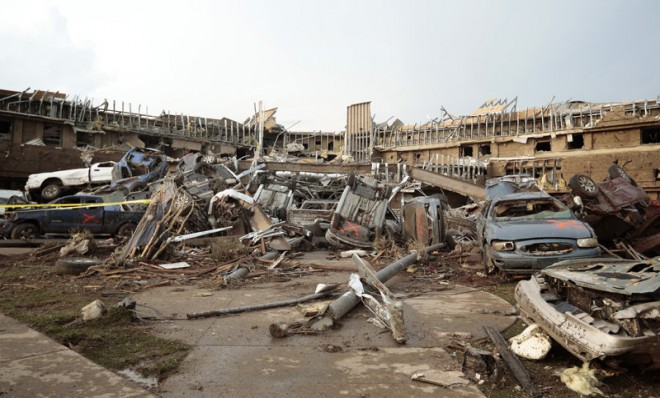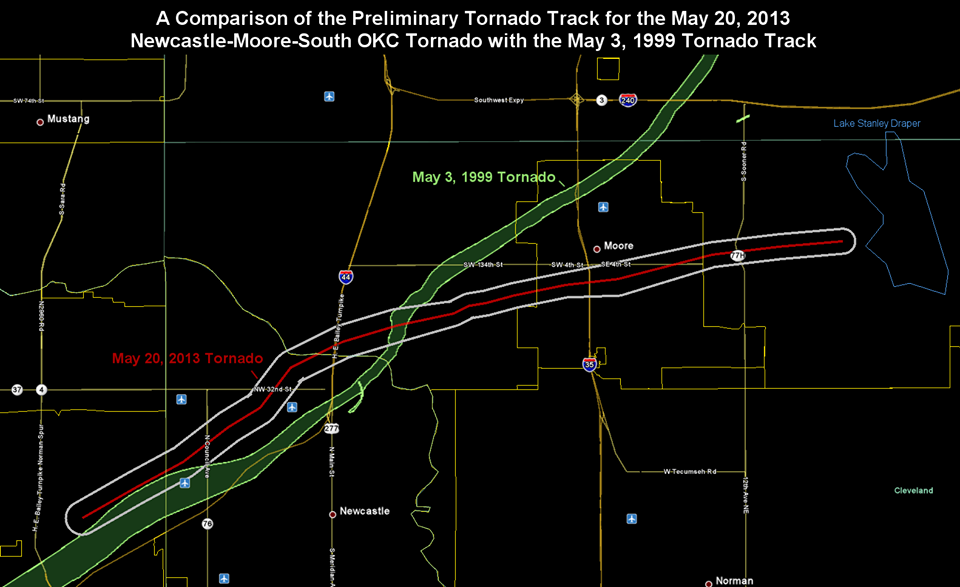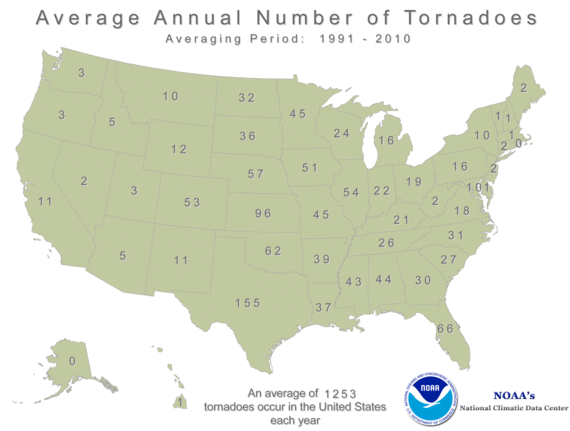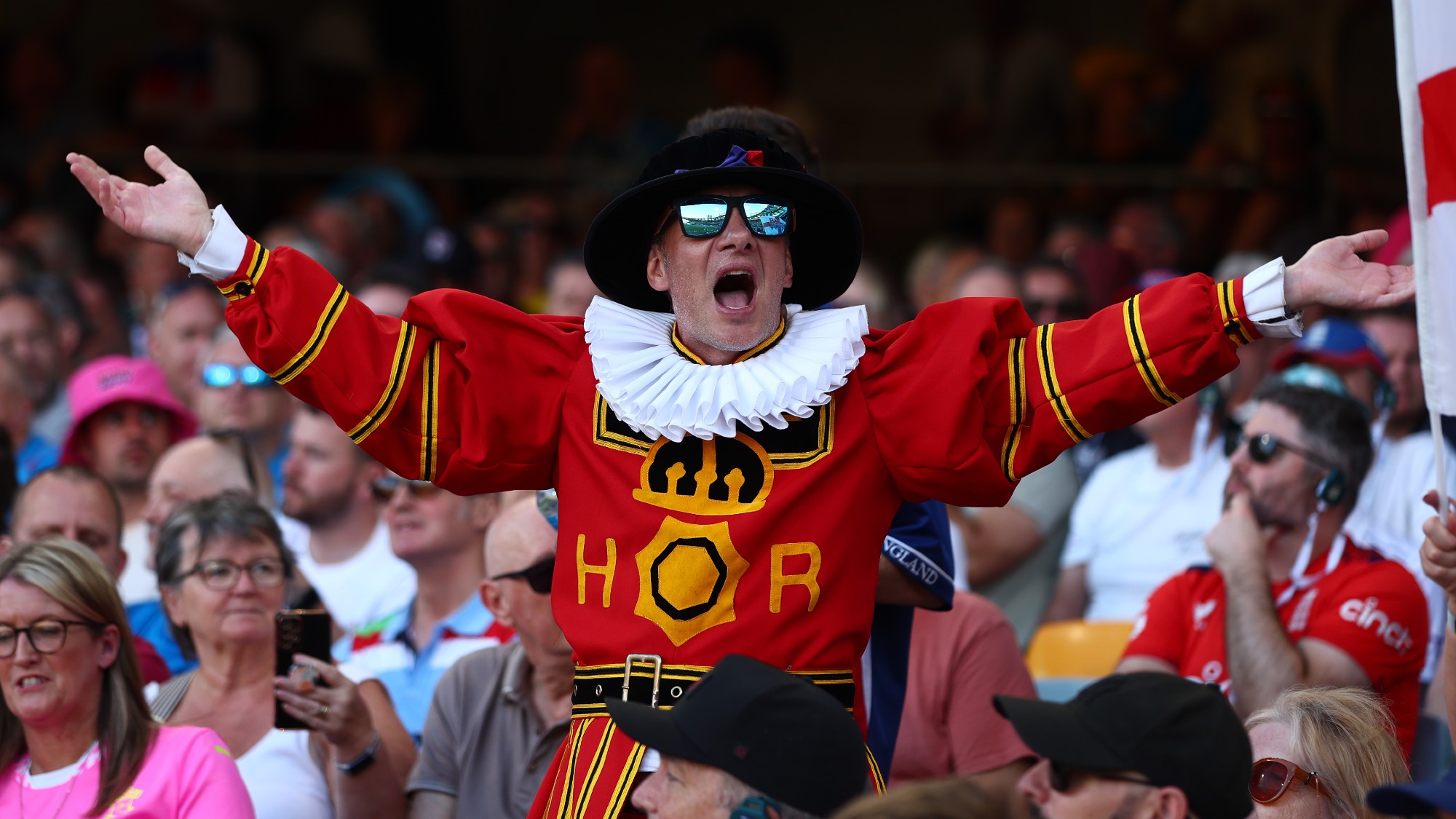Oklahoma City's ferocious tornado: What you should know
A massive tornado kills dozens of people in Moore — the second deadly tornado to ravage the Oklahoma City suburb in 15 years


The Oklahoma City suburb of Moore "could probably lay claim to being the very center of Tornado Alley," says Alexis Madrigal at The Atlantic, "an area roughly defined from north Texas to South Dakota, and west of the Mississippi River." A devastating tornado tore the town apart on May 3, 1999, with 302-mile-per-hour winds killing 36 people. The tornado that leveled much of Moore on Monday was much worse.
"A meteorologist for the local news station KFOR called the tornado 'the worst tornado in the history of the world,'" says Colin Schultz at Smithsonian Magazine. "That assessment is quite apt." Monday's twister, at least a mile wide, killed 91 people, including 20 children — and more fatalities are expected as rescue workers dig through the rubble. (UPDATE: On Tuesday morning, Oklahoma City's medical examiner lowered the confirmed death toll to 24.) President Obama late Monday authorized federal disaster aid for several tornado-hit counties in Oklahoma.

Just how big was the tornado?
The Week
Escape your echo chamber. Get the facts behind the news, plus analysis from multiple perspectives.

Sign up for The Week's Free Newsletters
From our morning news briefing to a weekly Good News Newsletter, get the best of The Week delivered directly to your inbox.
From our morning news briefing to a weekly Good News Newsletter, get the best of The Week delivered directly to your inbox.
Tornadoes are measured on the Enhanced Fujita scale, with 0 being the most mild and 5 being the worst. Monday's storm has initially been classified as a Category 4 tornado, but "many think it will be upgraded to an EF5 after further damage assessment," says The Atlantic's Madrigal. "The main thing to keep in mind is that anything EF4 or EF5 is likely to be very destructive if it hits near a human population center and stays near the ground for any period of time."
This tornado touched down at 2:56 p.m. and crawled 20 miles through Moore and neighboring Newcastle over the next 40 minutes. Some reports have the tornado at two miles wide. In terms of damage, "numerous neighborhoods were completely leveled," Sgt. Gary Knight of the Oklahoma City Police Department tells The New York Times. "Neighborhoods just wiped clean."
Here's the path the tornado took (in red), along with the path of the 1999 twister, from the National Weather Service. The New York Times has a street map of the tornado's path through Moore, with photographs.

Here's an amazing time-lapse video of the tornado, taken from a helicopter, from local station WMC-TV:
A free daily email with the biggest news stories of the day – and the best features from TheWeek.com
How does this tornado compare to others?
"There are a lot of parameters by which a tornado can be deemed the worst," says Smithsonian's Schultz, "and by pretty much all counts [Monday's] Moore tornado is up there."
The National Oceanographic and Atmospheric Administration keeps a list of historical tornadoes — devastating twisters known for their size, their duration, and their destruction. Though the Moore tornado doesn't trump any of them, its combination of size, strength, and duration made it an incredibly dangerous storm. [Smithsonian]
The largest tornado on record was two and a half miles wide, hitting Hallam, Neb., in 2004. The strongest, in terms of wind speed, was the 1999 twister that smacked Moore. Monday's tornado had winds of at least 199 mph. Forty minutes is a long time for a tornado to linger on the ground, but the record there goes to 1925's Tri-State Tornado, which ravaged Missouri, Illinois, and Indiana for three and a half hours, killing 695 people and flattening 15,000 houses.
Did Moore residents have any warning?
Yes. The tornado sirens sounded about 16 minutes before the tornado struck, which is considered on the longer side for tornado warnings. "The general problem with the warnings is that people might not hear or see them immediately, reducing the amount of time they have to find shelter," says The Atlantic's Madrigal. "The second problem is that the tornado hit during early rush hour," and lots of people were in their cars.
The other thing is that while 16 minutes is a bit longer than the average, "when such a storm decides that it will drop in front of you there's nothing to do but find the best available shelter and pray to be spared," says The Wall Street Journal in an editorial. "The cruelty of a tornado is that so often there is no time to evacuate." The City of Moore recommended that people hunker down in their houses or buildings, preferably in a below-ground shelter or at least a specially designated "safe room."
Why was the storm so deadly?
The high number of fatalities is due largely to bad luck: The tornado made a direct hit on Moore, and its path encompassed two elementary schools, a bowling alley, lots of residential neighborhoods, and the town's main hospital. There was also a potential element of faulty building quality and practices.
"Unfortunately, few homes in Moore have basements, and only about 10 percent or less have below-ground storm shelters," the city's website says. And even after the 1999 tornado, many of the houses — even the rebuilt ones — were constructed using techniques not well-suited to withstanding tornado-level winds, notes The Atlantic's Madrigal, citing research by engineer Timothy Marshall.
Why did Moore get hit twice in 15 years?
The short answer is bad luck and bad location. Some 75 percent of all tornadoes occur in the U.S., and Oklahoma is No. 4 on the list of tornado-prone states, after Texas, Kansas, and Florida. NOAA's National Weather Service has the numbers:

Even with Moore sitting uncomfortably in the middle of Tornado Alley, though, it's pretty rare for a spot to be hit twice. Here's the "storm shelters" section of City of Moore's website:
May 3rd was an extremely unique event weatherwise. There has never been such a strong and violent tornado ever in the recorded history of the City of Moore. Statistically, there is only about a 1-2% chance of a tornado — of any size — striking Moore on any particular day during the spring. But of all tornados that do strike us (again, not very many historically), there's only a less than 1% chance of it being as strong and violent as what we experienced on May 3rd. Put another way, there's a very small likelihood of Moore being struck by a tornado. There's an extremely smaller chance of Moore experiencing another "May 3rd" type event. If we are struck again, it will very likely be by a much less intense storm. [City of Moore]
What's the best thing to do when a tornado strikes?
According to Katja Friedrich at the University of Colorado's Department of Atmospheric and Oceanic Sciences (ATOC), the best thing to do — as the City of Moore suggests — is to "seek shelter in a basement or underground shelter." Then:
♦ If no basement is available, go to an interior room or hallway (stay away from windows and abandon mobile homes)♦ If caught outside, move as far away as possible from potential airborne objects and lie in the lowest spot available♦ Do not try to outrun a tornado in a car. Instead abandon the car and seek shelter in a low-lying area.♦ Do not seek shelter under highway overpasses, as wind speeds can be increased underneath the overpass [ATOC]
How can people help Moore recover?
If you want to send financial aid, disaster-relief agencies are asking for text-message donations. The donation will show up on your phone bill.
To donate $10 to the Red Cross, text the word REDCROSS to 90999
To donate $10 to the Salvation Army, text the word "storm" to 80888
KFOR-TV in Oklahoma City has more ways to help.
Sources: The Atlantic, City of Moore, CNN, KFOR, The New York Times, Popular Mechanics, Smithsonian, The Wall Street Journal, University of Colorado (PDF)
Peter has worked as a news and culture writer and editor at The Week since the site's launch in 2008. He covers politics, world affairs, religion and cultural currents. His journalism career began as a copy editor at a financial newswire and has included editorial positions at The New York Times Magazine, Facts on File, and Oregon State University.
-
 Quiz of The Week: 29 November – 5 December
Quiz of The Week: 29 November – 5 DecemberQuiz Have you been paying attention to The Week’s news?
-
 The week’s best photos
The week’s best photosIn Pictures A drive in the desert, prayers with pigeons, and more
-
 The Week Unwrapped: Will drought fuel global violence?
The Week Unwrapped: Will drought fuel global violence?Podcast Plus why did Trump pardon a drug-trafficking president? And are romantic comedies in terminal decline?
